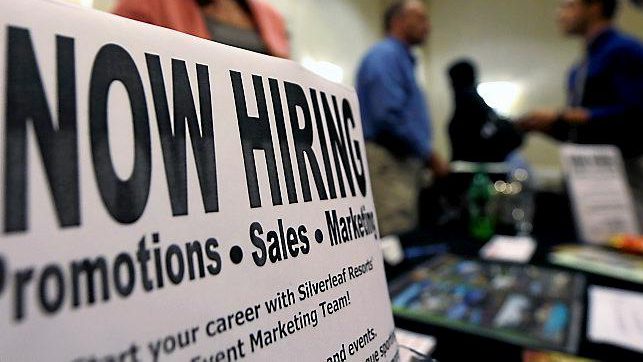At first blush, the conference break-out sessions bore titles reminiscent of an undergraduate course in global studies, like “Leadership and Cultural Competency” and “Tapping Into An Overlooked Talent Pool.” Keynote speaker Jon Baselice, a former immigration policy expert for the U.S. Chamber of Commerce, discussed navigating work visa programs to attract and retain workers, and a nonprofit advocate gave tips on managing “second-chance” workers with blemished records.
If those seminar-style trainings sound like they’re part of a course of study offered at a modern college campus, guess again. That was the agenda presented by the Minnesota Chamber of Commerce Foundation — which is attached to one of the most prominent business advocacy organizations in the state — for its annual Workforce Summit, dubbed “National Outlook, Minnesota Focus,” held Wednesday at the Minneapolis Marriott Northwest in Brooklyn Park.
At a time when new federal policies appear poised to slow international migration to the U.S. and cancel rhetoric around diversity and equity, why are some business advocates probing how to leverage all of the above? The answer can be summed up in one word: survival.
“You could be in hospitality. You could be at JP Morgan. You could be producing sheet metal,” said Baselice, addressing the audience. “If you don’t have the ability to hire who you need to hire, we’re kneecapping ourselves.”
Employers scrambling for labor
Nearly 100,000 Minnesotans exited the workforce during the early days of the pandemic and simply stopped looking for work. Thousands have since returned, but there’s still a sizable gulf between then and now, leaving employers scrambling for labor as the post-war “baby boom” generation continues to retire from a workforce held back by low birth rates and domestic out-migration to other states, especially in the college years.
Two trends are increasingly standing out to experts who study labor.
In 2022, the state’s unemployment rate fell to a record low of 2.3%, the lowest jobless rate in the nation.
At the same time, from 2020 to 2024, immigrants accounted for 94% of the net gains in the state’s population growth, according to a report from the Minnesota Chamber Foundation, “The Economic Contributions of New Americans in Minnesota.” Nearly 60% of the state’s labor force growth from 2019 through 2023 came from foreign-born workers.
Some might celebrate that Minnesota, which has a higher percentage of workers with bachelor’s and graduate degrees than neighboring states and most of the rest of the country, continues to enjoy lower rates of unemployment than the U.S. average.
But that’s not all good news, at least in the eyes of employers. When unemployment dips below 4% or 5%, economists raise concerns about inflation. Employers lacking sufficient labor face challenges expanding operations, or even in some cases maintaining basic services. A national shortage of school bus drivers, for instance, escalated during the pandemic, leading to widespread route delays and some route cancellations, as well as changes to school start times in St. Paul.
“There’s significant concern about these entry-level positions that businesses are unable to fill across the state,” said Jeanne Eglinton, vice president of employment services with MDI, a social enterprise company that manufactures plastic containers for clients such as Amazon and Frito-Lay.
MDI is able to keep the factory floors buzzing by relying on a workforce others shun. About half of the employees in the company’s three northern Minnesota plants would qualify as disabled, and 30% need special accommodations, Eglinton said.
Nine Lives and second chances at a new, nonprofit thrift store in St. Paul
Your Money: Financial planning tips for small-business owners
Working Strategies: Part 3: Preparing for a possible buyout or layoff
Consumer debt by gender: Is there a difference?
St. Paul and Minneapolis chambers of commerce consider merger — again
Health care impact
Operators of child care centers have blamed the labor shortage for a crisis in affordable care and the recent closures of some long-standing centers, such as the Hallie Q. Brown Center’s early learning program and another based at St. Catherine University, both of which operated for more than 90 years in St. Paul.
A shortage of home health aides comes at a time when the population is aging rapidly.
“The workforce shortage among home care providers has gotten continually more challenging over the last few years,” said Dan Atwood, a spokesperson for the Minnesota Home Care Association, in an email response to a reporter’s inquiry.
The labor shortage has left many Minnesota employers especially dependent on immigrant labor. Foreign-born individuals account for nearly one in 10 Minnesota workers, according to the American Immigration Council. One in five health care support workers in the state is an immigrant, as are nearly one in five workers in the computer industry, according to the council. Immigrants make up more than 14% of the state’s manufacturing workforce.
Some audience members at the Workforce Summit noted that for years, if not decades, most of the immigration rhetoric from the White House has focused on recruiting high-skill labor from other countries, as opposed to offering year-round work visas for working-class labor that some employers have grown desperate for.
“U.S. immigration policy since 1990 has focused on highly skilled positions, which is good. We value those,” said Ryan Vesey, a business development director with Greater Mankato Growth, the chamber of commerce for Blue Earth and Nicollet counties, which together share the fourth-lowest unemployment rate in the nation.
“But what is absent is a legal immigration process for these ‘low-skilled’ jobs, positions that in some cases take more skills than I have,” Vesey said. “There isn’t a year-round option right now for people who want to be machinists, welders, machine operators. All of those are in-demand positions. They don’t require a bachelor’s degree, but they still require important skills.”
Sean O’Neil, director of economic development and research for the Minnesota Chamber, noted that rural areas in particular would suffer net population losses without immigration, and even so are barely breaking even in many cases. Kandiyohi and Mower counties, for instance, barely gained a few dozen residents from 2020 to 2023. Without immigrants, they would have lost 481 and 506 residents, respectively.
O’Neil said a reasoned argument could be made that Minnesota is short on immigrants, especially outside the metro. Just 8.6% of the state’s population is considered foreign-born, compared to 14.3% of the U.S. as a whole. He noted 80% of the state’s immigrants are concentrated in just 10 Minnesota counties.
An out-migration of workers
Among long-standing pressures for employers, more baby boomers — workers born between 1946 and 1964 — are retiring than there are younger workers to replace them. American birth rates are low, and the number of Minnesotans leaving the state for opportunities like college, graduate school and jobs elsewhere accelerated in the first three years of this decade, according to the Minnesota Chamber.
“Minnesota hasn’t had a great track record in attracting more people than we’re losing to other states,” O’Neil said.
Net domestic migration — the movement of people living elsewhere in the country to Minnesota — was negative from 2020 to 2024, totaling a loss of 48,000 people. Minnesota ranked 41st among states for net domestic migration, and “there is little reason to expect any near-term changes that would dramatically improve overall population growth through domestic migration,” reads the report from the Minnesota Chamber Foundation.
In years past, those domestic losses have been offset by birth rates, which continue to plummet, and by international migration to Minnesota, which looks to slow under President Donald Trump. Recent executive orders have paused refugee resettlements entirely.
Minnesota’s total labor force spans some 3.1 million workers, and the state’s labor force participation rate — the percentage of the working-age population that is employed or actively seeking employment — stood in December at 67.8%, which also exceeds the national average of 62.5%, according to the Minnesota Department of Employment and Economic Development.
The Chamber Foundation found that labor force participation was even higher for foreign-born workers, at 74.3%, than the general population. Nationally, about 20% of U.S. workers are considered foreign-born, according to the U.S. Bureau of Labor Statistics, and that percentage has grown in the past 20 years.
“On the upside, Minnesota’s persistently low unemployment numbers point to steady demand from employers to fill jobs and meet demand,” reads an issue brief published last year by the Minnesota Chamber. “The downside is that Minnesota’s supply of available workers has not recovered from the exodus experienced in 2020 and early 2021 when more than 97,000 Minnesotans left the labor force.”
In short, according to the Minnesota Chamber, “Minnesota’s labor market remains very tight with far more job openings than job seekers.”
Uncertainties
It’s unclear how national debate around immigration will impact that trend.
John Perlich, vice president of government affairs for the St. Paul Area Chamber, said employers are looking for greater certainties as policies and economic outlooks shift moment to moment at the federal level. He and other members of the chamber spent some time on a recent Monday morning discussing how the Trump administration’s potential trade tariffs might impact St. Paul-area businesses and the local economy.
By that same afternoon, that information was outdated.
“Four hours later, all tariffs for Canada and Mexico were on hold,” said Perlich, in a recent interview. “Everybody’s kind of trying to build the plane as they fly it right now, knowing at some point in time, the plane will be out of spec because of changes at the federal level. … There’s cascading uncertainties for employers.”
Business advocates have noted that how a meatpacking plant that employs large numbers of immigrants in rural Minnesota is impacted by those shifting policies may be different than, say, a boutique information technology consulting firm in St. Paul, though both could be impacted by changing immigration patterns.
New climate
The total number of foreign-born residents in Minnesota with a bachelor’s degree or higher has nearly doubled since 2010, according to the report from the Chamber Foundation. Looking nationally, nearly half of Fortune 500 companies in the nation were started by immigrants or their children, O’Neil said.
Responding in part to federal threats to drop vendors that embrace diversity, equity and inclusion — or “DEI” — initiatives, Target recently joined other major retailers in scaling back outreach toward women, people of color and the LGBTQ+ community. That includes ending a multiyear, multimillion-dollar vendor program that promoted Black businesses. Boycotts have followed.
Some are taking the new climate in stride.
Rick Aguilar, longtime organizer of Aguilar Production’s annual Latino marketing conference and publisher of the West St. Paul-based community newspaper Latino American Today, called concerns about immigration raids potentially reducing the number of otherwise law-abiding workers overblown.
“You look at some of the liberal media, and everybody’s yelling the sky is falling,” he said. “I don’t think that’s right.”
Still, Aguilar noted that misunderstandings about the Latino workforce abound on all sides. Less than one-third of Latinos in the U.S. were immigrants as of 2021, according to the Pew Research Center, and 80% of Latinos in the country are U.S. citizens. When he began his conferences in 1997, the buying power of Latinos in the U.S. totaled $260 billion. Today, it’s closer to $3.4 trillion.
“We’re entrepreneurial,” Aguilar said. “We’re the fastest-growing business segment. We’re the largest minority community, and we have been for years.”




